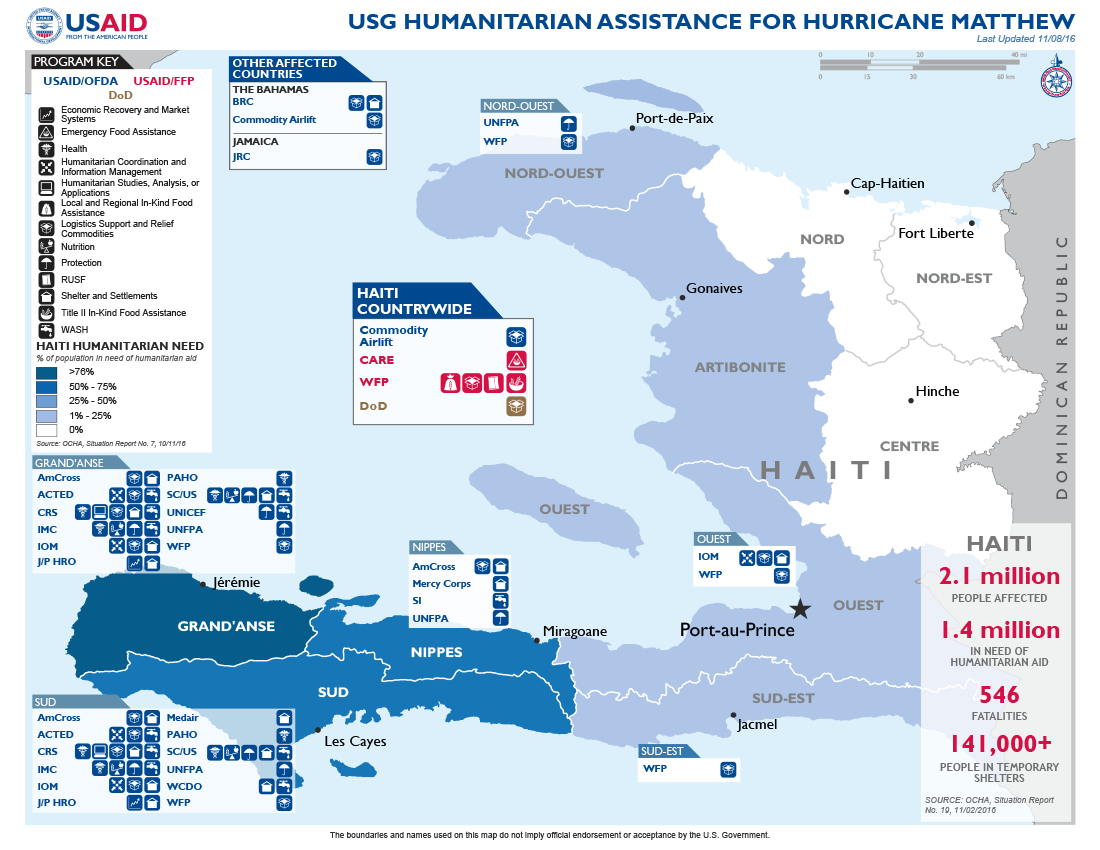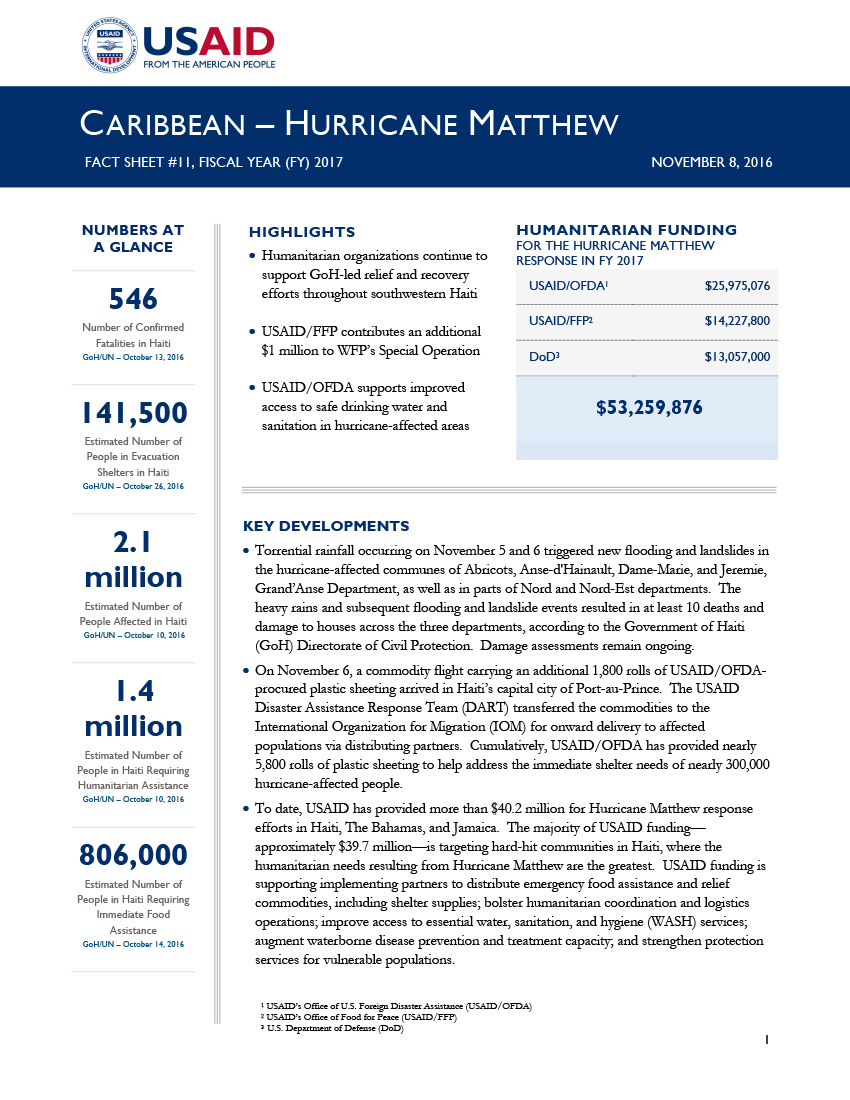November 8, 2016
Highlights
Humanitarian organizations continue to support GoH-led relief and recovery efforts throughout southwestern Haiti.
USAID/FFP contributes an additional $1 million to WFP’s Special Operation.
USAID/OFDA supports improved access to safe drinking water and sanitation in hurricane-affected areas.
Key Developments
Numbers At A Glance
546
141,500
2.1 million
1.4 million
806,000
Humanitarian Funding
For the Hurricane Matthew Response
in FY 2017
| USAID/OFDA | $25,975,076 |
| USAID/FFP | $14,227,800 |
| DoD | $13,057,000 |
| TOTAL | $53,259,876 |
Torrential rainfall occurring on November 5 and 6 triggered new flooding and landslides in the hurricane-affected communes of Abricots, Anse-d'Hainault, Dame-Marie, and Jeremie, Grand’Anse Department, as well as in parts of Nord and Nord-Est departments. The heavy rains and subsequent flooding and landslide events resulted in at least 10 deaths and damage to houses across the three departments, according to the Government of Haiti (GoH) Directorate of Civil Protection. Damage assessments remain ongoing.
On November 6, a commodity flight carrying an additional 1,800 rolls of USAID/OFDA-procured plastic sheeting arrived in Haiti’s capital city of Port-au-Prince. The USAID Disaster Assistance Response Team (DART) transferred the commodities to the International Organization for Migration (IOM) for onward delivery to affected populations via distributing partners. Cumulatively, USAID/OFDA has provided nearly 5,800 rolls of plastic sheeting to help address the immediate shelter needs of nearly 300,000 hurricane-affected people.
To date, USAID has provided more than $40.2 million for Hurricane Matthew response efforts in Haiti, The Bahamas, and Jamaica. The majority of USAID funding—approximately $39.7 million—is targeting hard-hit communities in Haiti, where the humanitarian needs resulting from Hurricane Matthew are the greatest. USAID funding is supporting implementing partners to distribute emergency food assistance and relief commodities, including shelter supplies; bolster humanitarian coordination and logistics operations; improve access to essential water, sanitation, and hygiene (WASH) services; augment waterborne disease prevention and treatment capacity; and strengthen protection services for vulnerable populations.
FOOD ASSISTANCE AND RELIEF COMMODITIES
The UN World Food Program (WFP) and implementing partners continue to support GoH-led relief and recovery efforts, including addressing the immediate food needs of hurricane-affected communities. As of November 3, WFP had distributed approximately 3,540 metric tons (MT) of food assistance in the hurricane-affected departments of Grand’Anse, Nippes, and Sud, reaching approximately 381,800 people by air, land, and sea. The organization’s blanket feeding program—conducted in conjunction with general food distributions—had reached approximately 1,100 people.
WFP dispatched 12 additional trucks to Jeremie and Sud’s Les Cayes commune, increasing the in-country vehicle fleet to 29 trucks and expanding the total humanitarian cargo capacity to 280 MT. The Logistics Working Group reports plans to deploy an additional helicopter to Les Cayes during the week of November 7; the additional aircraft will support distributions in hard-to-reach locations, including mountainous areas of Grand’Anse. As of November 7, one helicopter was servicing routes from Port-au-Prince to Grand-Anse and Sud, while a second helicopter was transporting relief commodities to areas surrounding Les Cayes. The Logistics Working Group also maintains two small vessels to support the transportation of relief commodities to coastal areas.
On November 7, USAID/FFP contributed an additional $1 million to WFP’s Special Operation, which seeks to facilitate the delivery of critical food assistance and relief commodities to hard-hit communities through robust logistical, telecommunications, and transportation capacity. The additional funding brings USAID’s total contribution for the Special Operation to $6.5 million.
During the week of October 31, Medair distributed USAID/OFDA-procured plastic sheeting, rope, hygiene kits, and Aquatabs to approximately 1,200 households in the neighborhoods of Tapion and La Cahouane, located in Sud’s Tiburon commune.
HEALTH AND WASH
Between October 21 and 27, the GoH Ministry of Public Health and Population (MSPP) issued cholera red alerts for 26 of Haiti’s 145 communes, including Grand’Anse’s Anse-d’Hainault, Chambellan, Dame-Marie, Jeremie, Les Irois, and Moron communes and Sud’s Chardonniers, Les Anglais, Les Cayes, and Port-a-Piment communes. Red alerts signify that one or more of the following criteria are met: 1) the commune registers the death of a suspected cholera case age five years or older; 2) the commune registers 10 or more suspected cholera cases ages five years or older; 3) the commune registers five or more suspected cholera cases in the same geographic area; 4) and/or diagnostic testing confirms at least one case of cholera. In total, the MSPP identified 1,058 suspected cases in Haiti between October 21 and 27. Additionally, health care workers reported more than 3,500 suspected cholera cases during the month of October, the UN Office for the Coordination of Humanitarian Affairs (OCHA) reports.
The U.S. Centers for Disease Control and Prevention (CDC) continues to support the MSPP to collect, analyze, and publish data on suspected cholera and other diarrheal diseases; strengthen diagnostic testing capacity; and conduct hygiene promotion activities. As of November 7, CDC laboratories were performing diagnostic tests on suspected cholera samples.
In coordination with GoH National Directorate of Water Supply and Sanitation (DINEPA), IOM has transported 38.1 MT of USAID/OFDA-supplied Calcium Hypochlorite (HTH)—a water treatment agent—to eight depots across the country to treat GoH-managed water systems. As of November 7, at least 6.2 MT of the HTH supply had been delivered to local water authorities in Artibonite, Nord, and Nord-Oeust departments, while additional deliveries to Centre, Nippes, Ouest, Sud, and Sud-Est are scheduled in the coming days. Additionally, CDC is working with DINEPA’s departmental office, rural sanitation officers, and professional operators in Grand’Anse to ensure prompt delivery of treatment supplies for public water systems.
The UN Children’s Fund (UNICEF) has deployed 13 mobile health teams to provide primary health care services and cholera vaccinations to communities in Grand’Anse. Moreover, 17 cholera rapid response teams are operational in Grand’Anse, Nippes, and Sud, according to OCHA.
USAID/OFDA is supporting NGO Solidaritiés International (SI) to improve access safe drinking water and mitigate the risk of waterborne disease transmission in hurricane-affected areas. USAID/OFDA-funded activities include immediate water trucking to areas where water supply systems sustained critical storm-related damage; supporting DINEPA to install and maintain three water treatment units in areas where the restoration of water supply systems is expected to extend beyond the emergency phase; and promoting safe hygiene practices through the distribution of hygiene kits. Cumulatively, SI-implemented WASH activities are targeting 140,000 people in Nippes. USAID/OFDA also recently committed an additional $162,000 to UNICEF to ensure the daily supply of treated water for at least 13,000 people in Jeremie for three months.
EDUCATION
Hurricane Matthew destroyed more than 520 schools and damaged approximately 3,450 others, according to a recent report prepared by the GoH Ministry of Economy and Finance, the Inter-American Development Bank, and the World Bank. The report, based on a series of rapid evaluations, estimates that the cumulative cost of damage to schools in Sud, Nippes, Grand’Anse, and Nord-Ouest, as well as on Ouest’s La Gonave Island, comprise $62.9 million.
As of November 2, more than 100,000 school-aged children were unable to resume classes due to the widespread damage to schools and other educational infrastructure. In response, the GoH Directorate for the Ministry of National Education and Vocational Training (MENFP) has revised the current calendar year and is developing an accelerated learning program to ensure that children who remain out of school are able to complete a full educational curriculum.
The GoH MENFP has identified a plan for repairing schools in hurricane-affected areas. In line with the GoH plan, UNICEF is conducting a series of interventions to ensure the rapid resumption of classes for school-aged children. UNICEF activities include refurbishing damaged schools, including WASH facilities, distributing educational materials to children and teachers, and providing affected schools with blackboards, desks, and other essential equipment. As of November 1, UNICEF has initiated repairs of 10 schools and distributed school supplies to eight schools in Les Cayes, reaching nearly 1,100 children.
In coordination with the MENFP, USAID/Haiti is providing nearly $1.5 million to UNICEF to enable the restoration of educational capacity in Grand’Anse, Nippes, and Sud. USAID/Haiti funding is supporting the rehabilitation of 50 schools across the three departments, the distribution of 45,000 kits for school-aged children and 1,000 kits for teachers, as well as the provision of instructional materials, school bags, and school furniture. Through its implementing partner UNICEF, USAID/Haiti aims to reach approximately 45,000 severely impacted students through these interventions.
PROTECTION
An estimated 125,000 children in hurricane-affected areas require protection assistance, according to UNICEF. Increasing food insecurity due to widespread crop, food stock, and livestock losses, as well as disruptions to education, are further amplifying the protection needs of children in hurricane-affected areas, the organization reports.
In coordination with the GoH Institute of Social Wellbeing and Research and humanitarian actors, UNICEF is establishing several child-friendly spaces to provide targeted psychosocial support and other assistance to vulnerable children and their families in Grand’Anse and Sud.
To date, USAID/OFDA has contributed nearly $837,000 to address the protection needs of vulnerable populations in hurricane-affected areas of Haiti. USAID/OFDA funding is supporting UNICEF to ensure that vulnerable children and households in Grand’Anse are protected from abuse, exploitation, and violence; the International Medical Corps (IMC) to implement protection activities, including conducting a rapid assessment of protection risks faced by women and girls and facilitating the creation of safe spaces for women and adolescent girls; and Save the Children/U.S. (SC/US) to provide information on protection needs and available services for children, facilitate the creation of child-friendly spaces at temporary shelter sites, and support recreational activities for children impacted the storm. Additionally, with USAID/OFDA support, the UN Population Fund (UNFPA) is facilitating coordination among sexual and gender-based violence response actors and supporting protection stakeholders to identify and respond to protection needs among vulnerable women, children, and adolescents in Grand’Anse, Nippes, Nord-Ouest, and Sud.
CONTEXT
Hurricane Matthew made initial landfall near Haiti’s Les Anglais commune, Sud, and secondary landfall over eastern Cuba on October 4 before continuing to traverse The Bahamas from October 5–7. The hurricane brought destructive winds, heavy rainfall, and dangerous storm surge, resulting in extensive damage to crops, houses, and infrastructure, as well as widespread flooding in some areas.
On October 2, U.S. Ambassador to Haiti Peter F. Mulrean and U.S. Chargé d’Affaires, a.i., for Jamaica Eric Khant issued disaster declarations in response to the anticipated effects of Hurricane Matthew. U.S. Chargé d’Affaires, a.i., Lisa A. Johnson issued a disaster declaration in response to the anticipated effects of Hurricane Matthew in The Bahamas on October 4.
USAID activated a regional DART on October 3 with staff in The Bahamas, Haiti, and Jamaica. USAID also stood up a Washington, D.C.-based Response Management Team to coordinate the regional humanitarian response.
Based on assessment findings and in consultation with government representatives in the two countries, USAID discontinued DART operations in Jamaica and The Bahamas on October 5 and 13, respectively. USAID/OFDA regional staff will continue to monitor USAID/OFDA assistance provided to the Bahamas Red Cross (BRC) and the Jamaica Red Cross (JRC) to address the immediate needs of populations affected by Hurricane Matthew.









Comment
Make a general inquiry or suggest an improvement.